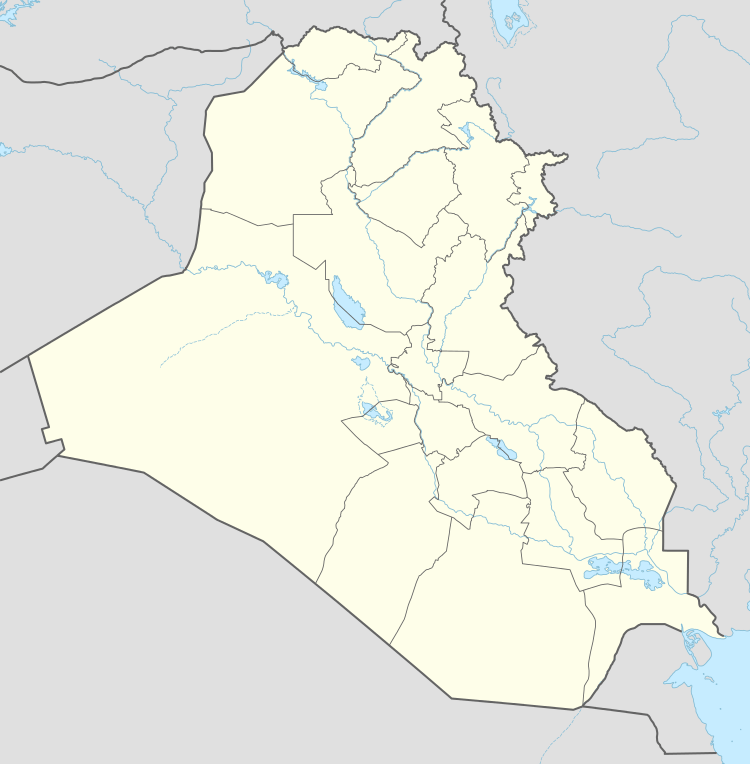Koy Sanjaq
Koy Sanjaq[nb 1] (Arabic: كويسنجق,[2] Hebrew: כוי סנג’ק,[3] Kurdish: کۆیە, romanized: Koye,[4][5] Syriac: ܟܘܝܐ)[6] is a town and district in Erbil Governorate in Kurdistan Region, Iraq.
Koy Sanjaq | |
|---|---|
 Koy Sanjaq Location in Iraq | |
| Coordinates: 36°04′59″N 44°37′47″E | |
| Country | |
| Region | |
| Governorate | Erbil Governorate |
| District | Koy Sinjaq District |
| Population (2013)[1] | |
| • Total | 21,026 |
In the town, there is a Chaldean Catholic church of Mar Yousif, constructed in 1923.[6]
Etymology
The name of the town is derived from "koy" ("village" in Turkish) and "sanjaq" ("flag" in Turkish), and thus Koy Sanjaq translates to "village of the flag".[7]
History
According to local tradition, Koy Sanjaq was founded by the son of an Ottoman sultan who planted his flag and established a garrison at the site of a seasonal bazaar after having defeated a rebellion at Baghdad, and developed into a town as locals moved to the settlement to provide services to the soldiers.[7] A Jewish community at Koy Sanjaq is first mentioned in the late 18th century, by which time it was already well established.[7] The community had its own graveyard,[3] and spoke both Jewish Neo-Aramaic and Sorani Kurdish.[8] A small Chaldean Catholic community was established in the town in the 19th century.[9] In 1913, 200 Chaldean Catholics populated Koy Sanjaq, and were served by two priests and one functioning church as part of the archdiocese of Kirkuk.[10]
The Iraqi census of 1947 recorded a total population of 8198 people, with 7746 Muslims, 268 Jews, and 184 Christians.[11] 80-100 Jews from the village of Betwata took refuge in the town for several months in 1950, increasing the size of the local community to 350-400 people, so to accompany the Jews of Koy Sanjaq when they emigrated to Israel in the following year.[11] Koy Sanjaq had a population of 10,379 in 1965.[1] The town was struck by Iranian airstrikes targeting the Kurdistan Democratic Party (KDP) base on 10 November 1994, resulting in the death of a civilian, and wounded three KDP militants.[12] In 1999, Assyrians from the nearby village of Armota protested the construction of a mosque in their village at Koy Sanjaq.[13] Koya University was established in 2003.[14]
35 displaced Assyrian families from Mosul were housed in a converted church building in the town in November 2014, and had not been rehoused as of April 2015.[15] As of March 2018, 60 Assyrian families inhabit Koy Sanjaq.[16] The Assyrian population largely speak Kurdish, but some continue to speak Syriac.[17] An Iranian missile attack on the Democratic Party of Iranian Kurdistan headquarters in the town on 8 September 2018 killed 14 people.[18]
Notable people
- Haji Qadir Koyi (1817-1897), Kurdish poet
- Dildar (1918-1948), Kurdish poet
- Tahir Tewfiq (1922–1987), Kurdish musician
- Fuad Masum (b. 1938), Kurdish politician
References
Notes
- Alternatively transliterated as Kūsanjaq, Koi Sanjaq, Kou Senjaq, Koisanjaq, Köy Sancak, Köi Sanjaq, Kuway Sandjaq, Kou Senjak, Kuysanjaq, Koysancak.[1]
Citations
- "Kūsanjaq". World Gazetteer. Retrieved 29 April 2020.
- "كويسنجق". Ishtar TV (in Arabic). Retrieved 29 April 2020.
- "Cemetery, Koi Senjaq (Koy Sinjaq), Iraq". Diarna: The Geo-Museum of North African and Middle Eastern Jewish Life. Retrieved 29 April 2020.
- "The Jerusalem Post: Êrişa Îranê ya li Koye peyamek e ji bo Amerîka, Erebistan û Îsraîlê". Rudaw Media Network (in Kurdish). 10 September 2018. Retrieved 19 December 2019.
- "ڕێگای کۆیە - تەقتەق دادەخرێت". Basnews (in Kurdish). 19 December 2019. Retrieved 19 December 2019.
- "Koysenjaq". Ishtar TV. 20 December 2012. Retrieved 29 April 2020.
- Mutzafi (2004), pp. 1-2.
- Mutzafi (2004), p. 5.
- Wilmshurst (2000), p. 127.
- Wilmshurst (2000), p. 176.
- Mutzafi (2004), p. 1.
- "Iranian Jets Bomb Kurdish Base in Iraq, Killing 1 and Hurting 3". New York Times. 10 November 1994. Retrieved 29 April 2020.
- Lalik (2018), pp. 236-237.
- "The University". Koya University. Retrieved 29 April 2020.
- "Displaced Christian families in Koya appeal not to be forgotten". World Vision International. 15 April 2015. Retrieved 29 April 2020.
- "Churches in Koya don't meet needs of Kurdistan's Christians". Rudaw Media Network. 13 March 2018. Retrieved 29 April 2020.
- Lalik (2018), pp. 235-236.
- "Iran rockets Kurdish parties' headquarters in Kurdistan Region's Koya". Rudaw Media Network. 8 September 2018. Retrieved 29 April 2020.
Bibliography
- Lalik, Krzysztof (2018). "Ethnic and Religious Factors of Chaldo-Assyrian Identity in an Interface with the Kurds in Iraqi Kurdistan". In Joanna Bocheńska (ed.). Rediscovering Kurdistan’s Cultures and Identities: The Call of the Cricket. Springer.
- Mutzafi, Hezy (2004). The Jewish Neo-Aramaic Dialect of Koy Sanjaq (Iraqi Kurdistan). Otto Harrassowitz Verlag.
- Wilmshurst, David (2000). The Ecclesiastical Organisation of the Church of the East, 1318–1913. Peeters Publishers.
| Wikimedia Commons has media related to Koy Sanjaq. |